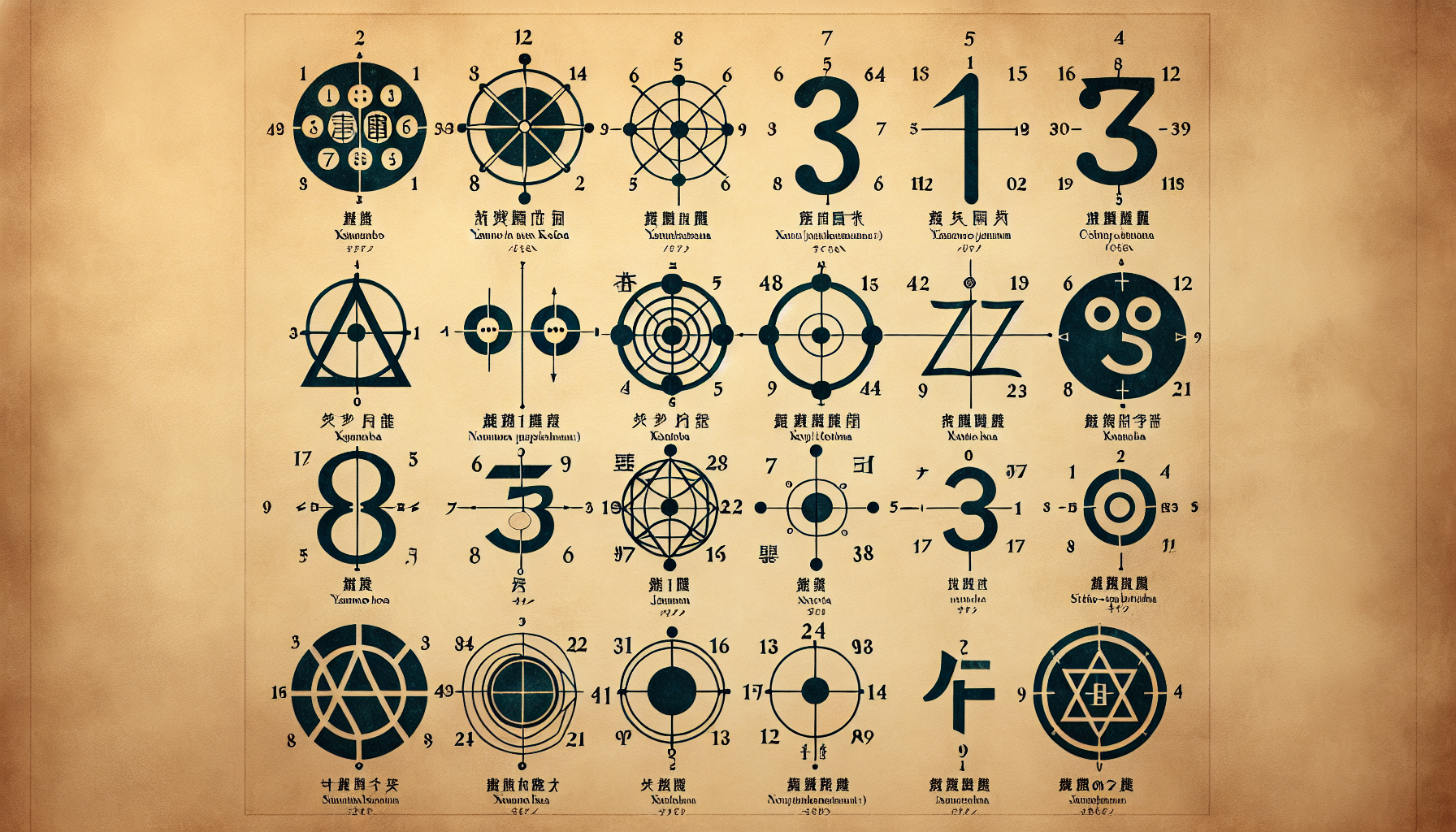Navigating how to count is a fundamental step in your Japanese language learning journey. This practical guide demystifies the process, providing you with the essentials to count from 1 to 10,000 and beyond. You’ll also learn how numbers weave into the fabric of daily life and culture in Japan, making you ready for real-world counting in no time.

Key Takeaways
- Mastering Japanese numbers involves understanding two readings (Yamato kotoba and Sino-Japanese) and kanji characters, crucial for fluency and cultural immersion.
- Japanese counters are essential for contextually counting objects, people, and living things, with common ones for time, people, animals, and objects, using specific counters like ‘ji’, ‘nin’, ‘hiki’, ‘tsu’, and ‘hon’.
- Cultural nuances in Japan give numbers beyond practical uses, with superstitions about lucky and unlucky numbers and wordplay for memorization, adding depth to language learning.
Understanding Japanese Numerals

The numerical landscape of Japanese is intriguing, shaped by a blend of indigenous Japanese elements and Chinese contributions, resulting in two primary number systems. Despite the common use of Arabic numerals, there’s a unique charm to the classic structure of Japanese numerals and how kanji characters are integral to their construction.
To become fluent in Japanese and fully engage with its language and cultural nuances, one must grasp the intricacies of the Japanese number system. Gaining proficiency in this area is vital for those who aspire to learn Japanese thoroughly.
The Dual Number Readings
In the Japanese language, numerals exhibit a distinctive dual nature. Native Japanese (yamato kotoba) readings are employed for enumerating quantities up to 10, while Sino-Japanese readings serve not only general counting but also apply in certain situations. This system of counting in Japanese intricately interweaves with counters indicating amounts of individuals, durations, and items—a feature that imbues complexity as well as depth into the language. Grasping these words—and notably numerals—is vital within this framework. To become proficient in Sino-Japanese numeral usage requires consistent practice and an understanding of their varied applications across different contexts.
The Role of Kanji Characters in Numbers
The Japanese writing system incorporates kanji characters as a fundamental element for denoting numbers. Each of the numbers from one to ten is symbolized by a unique kanji character. To express larger figures, these symbols are merged with additional kanji that represent higher denominations such as hundreds, thousands, and tens of thousands.
In various settings ranging from daily life to ceremonial traditions and formal paperwork, the use of the Japanese writing system underlines how integral kanji characters are within the framework of numbering in Japanese culture.
Counting Objects: The Use of Japanese Counters

The beauty of the Japanese language further unfolds when we delve into the concept of Japanese counters. Counters, or measures words, are essential for counting objects, people, or things in Japanese. They categorize objects according to features, and group similar objects together, enriching the conversation and helping the listener understand the context better.
With hundreds of categories leading to over 500 specific counters, the world of Japanese counters might seem overwhelming. Still, trust us, you don’t need to master all of them right away! Some common counters include:
- ‘ji’ for time
- ‘nin’ for people
- ‘hiki’ for small animals
- ‘tsu’ for objects
- ‘hon’ for long cylindrical objects
among others.
As you continue your journey of learning Japanese, you will gradually become familiar with more and more of these counters.
Common Counter Words for Everyday Items
Every day, we encounter numerous items and Japanese provides an exact counterword for nearly every type of object imaginable. The language boasts particular words for counting objects like ‘mai’ for flat items such as sheets of paper, garments, and plates, or ‘hon’ which is used to tally cylindrical shapes including bottles and pencils. The precision with which these Japanese counters categorize various objects is quite remarkable.
But what if you come across something that doesn’t fall neatly into a well-defined group? Fear not! For these more ambiguous objects, the versatile counters ‘tsu’ and ‘ko’ can be utilized in Japanese. So no matter what you are enumerating:
- tatami mats
- ensembles of apparel
- machinery and electronic gadgets
- sets of chopsticks
Japanese have a suitable counter word tailored just for it. Those words are referred to as japanese counter words!
Specialized Counters for Living Things
In the Japanese language, a unique aspect is the use of specific counters for various classifications of living entities. Here are some illustrative examples:
- ‘Hiki’ serves as the counter for small animals.
- For large creatures like horses and elephants, ‘tou’ is employed.
- There’s an exclusive counter for birds called ‘wa’
- Counting small fish requires using ‘bi’.
The intricacy within the Japanese language in how it distinguishes between different categories of life through its counting system is indeed captivating.
Japanese Numbers in Action: Practical Examples

Let’s apply what we’ve learned about the foundational elements by diving into Japanese numbers. Grasping kanji numerals is essential for navigating routine scenarios, as it enriches our involvement with common Japanese situations. Whether dealing with item prices, specifying addresses, or recording dates – now we’ll explore how these numerical symbols come to life in daily use.
Interacting with native speakers and noting their numerical expressions offers an invaluable perspective on real-world usage of Japanese. This deepens our comprehension and aids in advancing toward conversational proficiency. The role of counters is especially crucial here. They’re a key aspect that shapes the language within day-to-day exchanges and practical encounters.
Counting Currency and Prices
Counting currency and prices is one of the essential applications for Japanese numbers. The denominations of Japan’s currency, the yen (), include 1,000 (sen-en), 2,000 (nisen-en), 5,000 (go-sen-en) and 10,000 (ichi-man-en). Coins follow a similar counting pattern with denominations such as 100 (hyaku) and 500 (go-hyaku). It’s important to be aware that certain numbers have unique counting rules in Japanese. For instance, 300 is expressed as ‘san-byaku’, 600 as ‘roppyaku’, and 800 as ‘happyaku’.
Mastering these numerical conventions can significantly facilitate your experience with financial transactions while you are in Japan.
Time Telling with Japanese Numbers
Using Japanese numbers to tell time is a useful way of applying them in everyday life. The suffix ‘ji’ follows the number when expressing hours, so you’d say ‘san-ji’ for 3 o’clock. To signify AM and PM in Japanese, ‘gozen’ and ‘gogo’ are respectively used.
For stating minutes, add the suffix ‘fun’ right after the numerical value. Note that pronunciation can vary as seen with one minute being ‘ippun,’ while two minutes is said as ‘ni-fun.’’
Thus, when someone asks you “Ima nan-ji desu ka?” which means “What time is it now?” you’ll be well-prepared to respond correctly – isn’t learning Japanese fun?
Cultural Nuances: Lucky and Unlucky Numbers in Japan

Let us turn our attention from practical use to the intricate cultural significance that numbers hold in Japan. Deep-seated superstitions within Japanese culture imbue specific numerals with auspicious or ominous connotations. Such beliefs not only complicate but also enhance the richness and fascination of the Japanese language, contributing an additional dimension to its complexity.
Superstitions Surrounding Numbers
The numerals 4 (shi) and 9 (ku) are regarded as unlucky in Japan because they resemble the words for death and suffering. Turning 89 is thought to be unfortunate due to its connection with the word ‘calamity.’’ These beliefs regarding unlucky numbers impact many areas of daily life, such as the tradition of gift-giving where these particular numbers are often deliberately shunned.
Auspicious Combinations and Wordplay
The process of learning Japanese can be quite enjoyable, especially given that certain numbers are deemed auspicious in Japan. For instance, the digits 7 and 8—respectively pronounced as ‘shichi/nana’ and ‘hachi’—carry connotations of luck. The character for eight () even suggests expansion and wealth through its form. The language incorporates a playful numeric wordplay called ‘goroawase,’ where numbers gain additional significance thanks to their phonetic resemblance to words. This feature not only injects amusement into mastering Japanese, but also facilitates better recall of vocabulary related to numbers.
Advanced Counting in Japanese

Embarking on the journey of mastering advanced counting in Japanese, including grasping larger numbers and tallying up substantial amounts, might initially appear intimidating. Tackling this intricate aspect of Japanese numerals can ultimately be a fulfilling milestone in your quest for language learning proficiency.
Bigger Numbers and Their Pronunciations
Mastering the pronunciation and composition of larger numbers in the Japanese language requires a firm grasp of essential units such as ‘man’, ‘sen’, and ‘hyaku’. It’s important to have a solid foundation in base numbers from one through ten, which are vital for forming bigger numerical values within the Japanese numbering system. Unlike English, where large figures are grouped by threes, the Japanese structure their quantities based on groups of four. Therefore, “ten million” is articulated as ‘issen man,’ equating to one thousand instances of ten thousand.
Counting Large Quantities and Sets
In Japanese counting, big numbers are assembled using a stacking technique. This involves combining units such as ‘man’ for 10,000s, ‘sen’ for 1,000s, ‘ ’ signifying hundreds, ‘juu’ standing for tens and then the single-digit figures. As an example, the number sequence ‘hachi juu nana man roku sen kyuu ’ translates to the numeral figure of eight hundred seventy-six thousand nine hundred.
As you continue to practice this method regularly, it will become more familiar. Eventually you’ll effortlessly tally up substantial sums in Japanese with proficiency.
Enhancing Your Speaking Skills Through Counting
To boost speaking abilities and reach fluency in the Japanese language, it is essential to weave numbers into regular dialogue. Acquiring proficiency in the ‘tsu’ counting system proves highly useful for an array of daily contexts. This practice not only fosters greater confidence when conversing in Japanese, but also expands one’s comprehension of the linguistic framework.
Practice Scenarios for Counting
Mastering the skill of counting in Japanese can be effectively achieved by weaving it into everyday tasks. Whether you’re purchasing elongated items such as pens or tallying flat objects like sheets of paper or pieces of clothing, integrating counting practice into daily habits is a seamless strategy.
Engaging in frequent discussions with individuals who are native speakers can highlight specific areas that may need enhancement and offer extra chances to refine your proficiency.
Learning From Native Speaker Interactions
Engaging with native speakers provides a genuine opportunity for learning, allowing you to accurately pronounce numbers, use counters effectively during discussions, and grasp the subtle aspects of the language.
To achieve proficiency in counting in Japanese, it’s essential to practice regularly and intentionally within real-life situations.
Staying Motivated in Your Language Learning Journey
Embarking on the path of language learning is akin to setting out on an adventure, where maintaining motivation plays a crucial role in reaching your linguistic goals. Establishing particular time slots for study or holding yourself accountable to another individual regarding your learning agenda can amplify both productivity and motivational levels.
To avoid exhaustion and elevate involvement in the process, it’s beneficial to rejoice over personal milestones, ensure that study periods are pleasurable, and utilize resources that captivate your interest.
Setting Achievable Goals
In the pursuit of learning Japanese, it is essential to establish attainable objectives. It’s important to devise a study plan for language acquisition that can be seamlessly integrated into your everyday routine. To maintain motivation, set overarching targets like becoming proficient in counting up to a particular figure over six months or one year, as well as weekly short-term goals.
Incorporating study techniques that you find enjoyable could significantly boost your commitment to achieving these learning milestones.
Celebrating Milestones
Acknowledging and rejoicing in the strides you’ve made plays a crucial role in your educational path. If you find yourself grasping Japanese material that once stumped you, or if you reach the point where perusing texts becomes seamless without consulting a dictionary for words, these achievements are solid proof of your unwavering commitment and effort.
Take time to revel in each triumph as they come—let them be a source of inspiration pushing you toward even greater accomplishments in your learning journey.
Learning Japanese With Lingopie
Lingopie has made the process of learning Japanese an enjoyable and captivating activity. It transforms the act of binge-watching into a dynamic language learning session by enhancing your Netflix experience with features such as:
- Immediate translations
- Simultaneous dual subtitles
- Adjustable playback speed
- A function to save and practice new words
If you’re aiming to master a Japanese through Tv series or delving into Lingopie’s extensive collection of native shows from various nations, this platform offers a novel approach to deeply engage with both the language and its cultural context.
Related:

Summary
In this journey through Japanese numbers and counters, we have explored the dualality of native and Sino-Japanese readings, the role of kanji characters, the intricacies of Japanese counters, and the cultural nuances surrounding lucky and unlucky numbers. We’ve also put our knowledge into practical use with real-life examples, mastered advanced counting, and learned how to enhance speaking skills through counting. Importantly, we have understood the value of setting achievable goals and celebrating milestones to stay motivated in our language learning journey. As you continue to immerse yourself in the rich world of the Japanese language, remember, each number you count brings you one step closer to fluency!
Frequently Asked Questions
How do you count to 10 in Japan?
In Japanese, the sequence to count up to ten is: “hitotsu” for one, “futatsu” for two, “mittsu” for three, “yottsu” for four, and “itsutsu” five. Followed by six as “muttsu,” seven as “nanatsu”, eight as “yattsu”, nine is called “kokonotsu” and finally ten is referred to as “tou.”
Having learned this native numerical system in Japanese now enables you to confidently count from one through ten!
Is it Nana or Shichi?
In the Japanese language, “nana” and “shichi” are both accepted ways to say the number seven. Each term is widely utilized and recognized as correct.
Your choice between using “nana” or “shichi” can be determined by personal preference. Either one is perfectly suitable.
How do I learn Japanese by myself?
Begin your journey into the Japanese language by utilizing applications such as Duolingo, Memrise, or Rosetta Stone. These tools are excellent for acquiring foundational elements of the language like basic phrases, vocabulary, and understanding the alphabet. Enhance your grasp of both Japanese linguistic nuances and cultural aspects through engagement with anime, films, television series, listening to music and podcasts, and preparing traditional Japanese dishes. And fostering friendships with individuals who speak Japanese.
Such a comprehensive approach is conducive to enriching your educational venture in learning Japanese and will facilitate swift advancement in mastering the language.
What are Japanese counters and how are they used?
In the Japanese language, counters, also referred to as measure words, are vital for quantifying and classifying objects or individuals according to their characteristics by grouping alike entities. Achieving proficiency in these counters is crucial for fluent Japanese communication.
How can I practice Japanese counting in everyday life?
Incorporate Japanese counting into everyday tasks, such as tallying up products while shopping, and use the correct numerical classifiers for various items, including those that are elongated. Engage in this practice to make learning fun!







![How To Use Mo (も) Particle In Japanese Grammar [Guide]](/blog/content/images/size/w300/2025/06/How-To-Use-Mo-----Particle-In-Japanese-Grammar.jpg)


